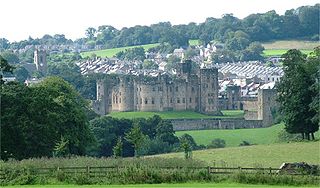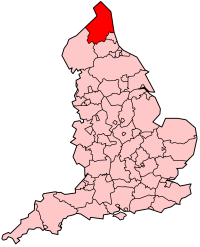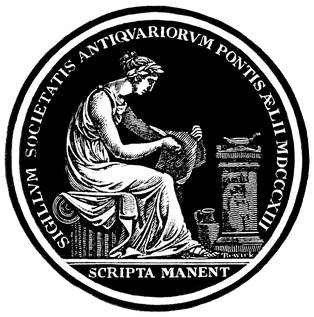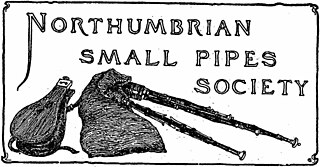
Rock Hall is a privately owned 18th-century country house, at Rock, Rennington, near Alnwick, Northumberland (grid reference NU20082026 ). It is a Grade II* listed building. [1]

Rock Hall is a privately owned 18th-century country house, at Rock, Rennington, near Alnwick, Northumberland (grid reference NU20082026 ). It is a Grade II* listed building. [1]
The Manor of Rock was owned by several Northumbrian families, Rock, Swinhoe, Lawson, Salkeld (1620–1705), Proctor. It passed into the Villiers family, and the estate was sold in 1794 by George Villiers, 4th Earl of Jersey to Peter Holford. At this period the house itself was a burnt-out ruin. Robert Holford, to whom it passed on his father Peter Holford's death in 1804, transferred it that year to Charles Bosanquet, married to his sister Charlotte. [2] [3]
There was a house on the estate from the 14th century. The south wing was converted to a tower house in the 15th century and the whole was remodelled by the Salkelds in the 17th century. [4] [5]
Badly damaged by fire in 1752, the house was restored around 1819 by Charles Bosanquet, [6] for whom architect John Dobson created two octagonal wings attached to the pele tower on its south front, as well as stables and a coach house. [7] A new north-west wing was added by architect F.R. Wilson in the mid 19th century. [5] Members of the Bosanquet family born at Rock include scientist Robert Bosanquet, Admiral Sir Day Bosanquet and philosopher Bernard Bosanquet. Professor Robert Carr Bosanquet, an archaeologist, also lived at Rock Hall. [8]
In 1881 the estate comprised 1,130 acres (4.6 km2), employing 44 staff on the land and 11 in the house. [9] From 1929 to 1939 the house was leased by Helen Christian Sutherland, an art patron and friend to well known writers and intellectuals. During her residence the house displayed much of her art collection and often hosted her circle of friends, including David Jones and Ben Nicholson [10] [11] and members of the Ashington Group. [12]
In 1948, the house was leased at a peppercorn rent to the Youth Hostel Association by Charles Ion Carr Bosanquet, for an initial term of 30 years. [13] [14] An 80-bed hostel was duly opened by Lord Beveridge on 27 May 1950, [15] [16] and subsequently more than 10,000 overnight stays were recorded in peak years. [lower-alpha 1] It remained in use until 1991, when the lease [lower-alpha 2] was revoked. [14]
The following year, the building was taken over by nearby Rock Moor School, founded in 1984 by (Mrs) Lalage Bosanquet. This had begun life as a private nursery school, but in 1988, indicated that it would start taking children up the age of 11. [14] [19] [20] By 1994, when it sought status as a charitable trust, the renamed Rock Hall School was accepting new pupils aged 3 to 13. [21] This co-educational preparatory school [22] closed in 2013, after which Rock Hall reverted to being a private residence. [14]

Northumberland is a ceremonial county in North East England, bordering Scotland. It is bordered by the Scottish Borders to the north, the North Sea to the east, Tyne and Wear and County Durham to the south, and Cumbria to the west. The town of Blyth is the largest settlement.

Alnwick is a market town in Northumberland, England, of which it is the traditional county town. The population at the 2011 Census was 8,116.

Amble is a town on the North Sea coast of Northumberland, England, at the mouth of the River Coquet; Coquet Island is visible from its beaches and harbour. In 2011, the parish of Amble by the Sea had a population of 6,025.

Northumberland, England's northernmost county, is a land where Roman occupiers once guarded a walled frontier, Anglian invaders fought with Celtic natives, and Norman lords built castles to suppress rebellion and defend a contested border with Scotland. The present-day county is a vestige of an independent kingdom that once stretched from Edinburgh to the Humber, hence its name, meaning literally 'north of the Humber'. Reflecting its tumultuous past, Northumberland has more castles than any other county in England, and the greatest number of recognised battle sites. Once an economically important region that supplied much of the coal that powered the industrial revolution, Northumberland is now a primarily rural county with a small and gradually shrinking population.

Fallodon is a hamlet and former civil parish, now in the parish of Newton-by-the-Sea, in the county of Northumberland, England. It is the territorial designation of Viscount Grey of Fallodon and Baronet Grey of Fallodon. It is pronounced with the emphasis on the first syllable.

Berwick-upon-Tweed is a parliamentary constituency in Northumberland represented in the House of Commons of the UK Parliament since 2015 by Anne-Marie Trevelyan, a Conservative.
This is a list of the High Sheriffs of the English county of Northumberland. The High Sheriff is the oldest secular office under the Crown. Formerly the High Sheriff was the principal law enforcement officer in the county but over the centuries most of the responsibilities associated with the post have been transferred elsewhere or are now defunct, so that its functions are now largely ceremonial. The High Sheriff changes every March.
Robert Holford Macdowall Bosanquet was an English scientist and music theorist, and brother of Admiral Sir Day Bosanquet, and philosopher Bernard Bosanquet.

Grundy's Wonders is a Tyne Tees Television architecture programme presented by John Grundy, which began in 2000.
Newcastle-upon-Tyne was a parliamentary borough in the county of Northumberland of the House of Commons of England from 1283 to 1706, then of the House of Commons of Great Britain from 1707 to 1800 and of the House of Commons of the United Kingdom from 1801 to 1918. It returned two Members of Parliament (MPs), elected by the bloc vote system.
John and Benjamin Green were a father and son who worked in partnership as architects in North East England during the early nineteenth century. John, the father was a civil engineer as well as an architect. Although they did carry out some commissions separately, they were given joint credit for many of their projects, and it is difficult to attribute much of their work to a single individual. In general, John Green worked on civil engineering projects, such as road and rail bridges, whereas Benjamin worked on projects that were more purely architectural. Their work was predominantly church and railway architecture, with a sprinkling of public buildings that includes their masterpiece, Newcastle's Theatre Royal.
Charles Bosanquet was an English colonial official and writer.

Rock is a village and former civil parish, now in the parish of Rennington, in Northumberland, England about 5 miles (8 km) north of Alnwick. In 1951 the parish had a population of 162.

The Society of Antiquaries of Newcastle upon Tyne, the oldest provincial antiquarian society in England, was founded in 1813. It is a registered charity under English law.

The Church of St Michael in Alnham, in the English county of Northumberland, is a medieval structure dating from circa 1200. Built on a Roman camp site, it is mentioned in records dating to 1291; it is a Grade I listed building.
Charles Ion Carr Bosanquet was a Vice‑chancellor of Durham University, and the first Vice-chancellor of Newcastle University.
Joseph West (1910–1965) was an English footballer who played as a forward in the Football League for Cardiff City and Darlington.

The Northumbrian Small Pipes Society was founded in 1893, by members of the Society of Antiquaries of Newcastle upon Tyne to promote interest in, and playing of Northumbrian smallpipes, and their music. As it only continued in existence for seven years, it is now regarded primarily as a short-lived precursor to the Northumbrian Pipers' Society. However, despite its short life, it played a significant role, publishing the first tutor for the instrument, J. W. Fenwick's Instruction Book for the Northumbrian Small-Pipes (1896), holding regular meetings, and organising annual competitions. In 1894 and 1896–7, the society published Transactions, as well as publishing an account of their Annual Meeting of 1897. As well as Members, who paid an annual 5s. subscription, there was a category of Honorary Playing Members. Since the society's records include the names and addresses of all members, of either kind, they have listed the names and addresses for 37 known pipers. Two articles in the Newcastle Courant, in April 1900, gave an account of their Annual General Meeting, at the Literary and Philosophical Society, and referred to the society as flourishing, with 200 members, of whom almost half were pipers. Officers were elected for the following year; however there is no subsequent record of any formal activity of the society, such as meetings or competitions. In 1906, when the Cloughs played for King Edward VII at Alnwick Castle, an account of this in the Berwickshire News stated that the Northumbrian Small Pipes Society had done some good work in reviving interest, but that 'seven winters had passed without it giving any signs of life'. This suggests that the society had been largely inactive for some time before its final AGM.

David Stephenson (1757–1819) was an English architect who worked in Newcastle upon Tyne and Northumberland. He was the first Newcastle architect trained in London and was "Newcastle's and the North East's leading architect" at the start of the 19th century.

William Dickson (1799–1875) was a solicitor, magistrate, banker and antiquary associated with Alnwick, Northumberland, England.